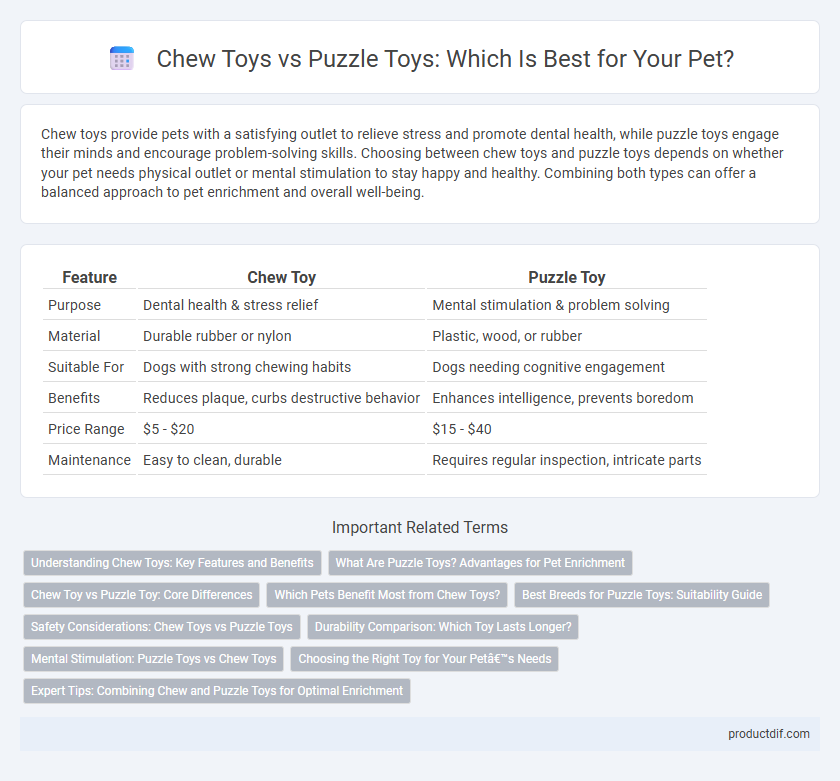Chew toys provide pets with a satisfying outlet to relieve stress and promote dental health, while puzzle toys engage their minds and encourage problem-solving skills. Choosing between chew toys and puzzle toys depends on whether your pet needs physical outlet or mental stimulation to stay happy and healthy. Combining both types can offer a balanced approach to pet enrichment and overall well-being.
Table of Comparison
| Feature | Chew Toy | Puzzle Toy |
|---|---|---|
| Purpose | Dental health & stress relief | Mental stimulation & problem solving |
| Material | Durable rubber or nylon | Plastic, wood, or rubber |
| Suitable For | Dogs with strong chewing habits | Dogs needing cognitive engagement |
| Benefits | Reduces plaque, curbs destructive behavior | Enhances intelligence, prevents boredom |
| Price Range | $5 - $20 | $15 - $40 |
| Maintenance | Easy to clean, durable | Requires regular inspection, intricate parts |
Understanding Chew Toys: Key Features and Benefits
Chew toys are designed to satisfy pets' natural urge to gnaw, promoting dental health by reducing plaque and tartar buildup through constant chewing action. Made from durable, non-toxic materials like rubber or nylon, these toys help prevent destructive behavior by redirecting chewing impulses onto safe objects. Regular use of chew toys supports strong jaw muscles and can alleviate anxiety in dogs and cats by providing a consistent outlet for stress relief.
What Are Puzzle Toys? Advantages for Pet Enrichment
Puzzle toys for pets are interactive playthings designed to stimulate a pet's problem-solving skills and mental agility by requiring them to manipulate parts to access hidden treats. These toys enhance cognitive function, reduce boredom, and alleviate anxiety by providing engaging challenges that mimic natural foraging behaviors. Unlike chew toys that primarily satisfy oral needs, puzzle toys promote mental enrichment and improve overall well-being through sustained intellectual engagement.
Chew Toy vs Puzzle Toy: Core Differences
Chew toys primarily promote dental health and satisfy natural chewing instincts in pets, while puzzle toys engage cognitive skills by challenging pets to solve problems for rewards. Chew toys are typically made of durable materials like rubber or nylon to withstand biting, whereas puzzle toys incorporate compartments and mechanisms that conceal treats or kibble. Understanding these core differences helps pet owners select toys that best support their pet's physical and mental well-being.
Which Pets Benefit Most from Chew Toys?
Chew toys primarily benefit dogs and small mammals like rabbits and guinea pigs by promoting dental health and reducing anxiety through natural chewing behaviors. Dogs with strong chewing instincts, such as terriers and retrievers, especially gain from durable chew toys that prevent destructive habits and maintain oral hygiene. While puzzle toys stimulate cognitive skills, chew toys are essential for pets requiring physical outlet and jaw exercise.
Best Breeds for Puzzle Toys: Suitability Guide
Puzzle toys are best suited for intelligent and active dog breeds like Border Collies, German Shepherds, and Poodles, as these breeds thrive on mental stimulation and problem-solving challenges. Chew toys, while beneficial for all dogs, are particularly ideal for puppies and strong chewers such as Bulldogs and Pit Bulls to satisfy their natural urge to chew and promote dental health. Selecting the appropriate toy type based on breed-specific behavior enhances engagement and overall well-being.
Safety Considerations: Chew Toys vs Puzzle Toys
Chew toys are designed to withstand biting and help maintain dental health, but safety considerations include choosing non-toxic, durable materials to prevent choking or ingestion of harmful fragments. Puzzle toys require safe construction with secure compartments to avoid small parts breaking off and posing a choking hazard, especially for aggressive chewers or pets prone to tearing toys apart. Selecting appropriate toys based on a pet's chewing strength and play habits ensures effective safety management for both chew and puzzle toys.
Durability Comparison: Which Toy Lasts Longer?
Chew toys are typically made from tough materials like rubber or nylon, designed to withstand strong biting and chewing, making them highly durable for aggressive chewers. Puzzle toys, often constructed with plastic or composite materials, offer moderate durability but can wear down faster under constant use due to moving parts and intricate designs. In terms of longevity, chew toys generally last longer for intensive use, while puzzle toys prioritize mental stimulation over extreme durability.
Mental Stimulation: Puzzle Toys vs Chew Toys
Puzzle toys provide superior mental stimulation by challenging pets to solve problems and retrieve hidden treats, enhancing cognitive skills and preventing boredom. Chew toys primarily satisfy the natural urge to gnaw, offering physical engagement without significant cognitive challenges. Incorporating puzzle toys into pet play routines supports mental development, while chew toys mainly contribute to dental health and stress relief.
Choosing the Right Toy for Your Pet’s Needs
Chew toys are ideal for pets needing to satisfy natural chewing instincts and promote dental health by reducing plaque and tartar buildup. Puzzle toys stimulate mental activity, helping to alleviate boredom and improve cognitive skills through problem-solving challenges. Selecting the right toy depends on your pet's behavior, age, and specific needs, ensuring both physical exercise and mental stimulation are balanced.
Expert Tips: Combining Chew and Puzzle Toys for Optimal Enrichment
Experts recommend combining chew toys and puzzle toys to maximize mental stimulation and dental health in pets. Chew toys help satisfy natural chewing instincts and promote healthy teeth, while puzzle toys challenge pets cognitively and reduce boredom. Integrating both types enhances overall enrichment, supporting well-rounded physical and mental exercise.
Chew Toy vs Puzzle Toy Infographic

 productdif.com
productdif.com